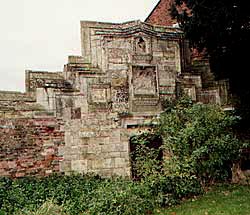< Previous | Contents | Next >
Rampton
 The early 16th century gateway to the original
Manor House (demolished in 1851-3). Pevsner describes it as "an
uncommonly lavish piece of Early Tudor brickwork, rising in three
stepped stages and adorned with corbelled-out panels of terracotta
with coats of arms". (A. Nicholson, 2001).
The early 16th century gateway to the original
Manor House (demolished in 1851-3). Pevsner describes it as "an
uncommonly lavish piece of Early Tudor brickwork, rising in three
stepped stages and adorned with corbelled-out panels of terracotta
with coats of arms". (A. Nicholson, 2001).Seven Thanes had seven manors or mansions here,’ says Thoroton in referring to Rampton in Saxon times. The village stands within a mile or two of the Trent along the Lincolnshire border, and has been the residence of ancient and eminent families. After the Conquest that mighty Norman warrior, Roger de Builli, became possessed of the lands of the Saxon nobles, and succeeding him one of the earliest owners of whom definite mention is made is Nigellus de Rampton, whose daughter. carried it by marriage to Robert Malluvell. This family became extinct in the male line, after which the manor came by other marriage alliances into the possession of the Stanhopes, who held it for six generations, when Saunchia Stanhope married John Babington, and the Babingtons retained it for four generations more. John Babington married a daughter of Hercy Nevile, of Grove, and on his death left as his co-heiresses his two daughters, Barbara and Elizabeth. Widow Babington took for her second husband Anthony Eyre, who had a son, Gervase. This son fell in love with Elizabeth, the heiress of a moiety, and he purchased the other moiety which was the portion of Barbara.
Rampton has remained in the hands of the gallant family of Eyre ever since. Its members come of ancient lineage, for William le Eyre of Hope held lands of Henry III., in capite, by the service of the custody of the Forest of the Peak in Derbyshire. From him was descended Gervase Eyre, who took a prominent part on the side of the Royalists in the wars of Charles I.’s time. He was given the command of a troop of horse, and participated in the many conflicts by which the Newark cavalry succeeded in making itself conspicuous for its bravery and prowess.
When the ancient castle was besieged, and Prince Rupert hastened to its relief, Sir Gervase Eyre’s regiment of horse was entrusted with the duty of preventing the two wings of the enemy’s forces from uniting. In 1645 the gallant soldier was slain in action, and his body was interred at Rampton, where there is a brass inscribed to his memory.
Throsby speaks of the house which Sir Gervase and his predecessors, the Babingtons, occupied as ‘a large old mansion, built so long back as the time of Henry VIII.’ Only a fine stone gateway which led to it now remains, at the north-east corner of the churchyard, for the house was taken down about 1730, and the family removed to Grove, where they had a residence. The village saw little of its owners for about a century, but in 1853 they again made it their home, and a splendid Elizabethan mansion uprose worthy of its possessors.

All Saints' church, Rampton. The church contains Early English and Perpendicular fabric (A. Nicholson, 2001).
The ancient church contains many memorials of the Stanhopes, Babingtons, and Eyres. In one of them Gervase Eyre, who represented the county in Parliament, is described as entitled to the favour of ‘all true friends of the Church and Constitution’; while his mother, Lady Packington, was so esteemed for her piety that the authorship of a once popular book, ‘The Whole Duty of Man,’ was attributed to her. There is also a tablet to the memory of Vice-Admiral Sir George Eyre, K.C.B., G.C.M.G., who died in 1839, after having seen much active service in the French wars; while another tells of the sacrifices the Eyres have made in the cause of their country in later times. Lieutenant Eyre was killed in the Ashantee War in 1874, when only twenty-three years old, and his father, Lieutenant-General Sir William Eyre, was one of the heroes of the Crimea.
Rampton now belongs to Colonel Eyre, C.B., the much esteemed member for the Gainsborough Division, who was wounded in the attack on the Redan, and was at the siege of Lucknow during the Indian Mutiny.
